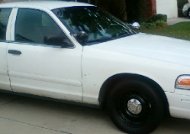12/15/2010
Maryland: Federal Court Overrules Window Crack Traffic StopFederal judge rules, in essence, that Baltimore, Maryland police lied about traffic stop.

A federal judge last week overturned the result of a traffic stop in Baltimore, Maryland after the reason for the stop was found to be bogus. On January 26 at around 1:30pm, Baltimore City Police Officers Jimmy Shetterly, Frank Schneider, and Manuel Moro ordered a white Ford Crown Victoria with tinted windows to pull over while driving on Pennsylvania Avenue near Mosher Street. As part of the Central District Operations Unit, the officers saw their mission as "proactive crime fighting" and instead of waiting for calls, their mission was to go and find a crime. The officer sitting in the back seat of the patrol car found one in the form of a claimed vehicle defect.
"Notably, Officer Moro's version of events indicates that from his position in the rear of the police vehicle, he could identify a crack in a windshield on the right passenger side of a car, turning right, away from the police vehicle, through his own vehicle's windshield, and across an intersection," Judge Richard D. Bennett wrote. "All three officers testified that after they turned left onto Mosher Street following the Crown Victoria, they could see through the tinted rear window of the Crown Victoria and could identify the crack in the windshield, notwithstanding the fact that there were three passengers between the officers and the windshield."
During the stop, the officers asked for permission to search the Ford. The driver consented. Travis Gaines was a backseat passenger and could not open the doors from the inside because the Ford used to be a police car. So to get out, Gaines began climbing over the front seat. This caused Officer Shetterly to become concerned. He opened the door, allowed Gaines to exit, then searched him. He found Gaines had been illegally carrying a Bryco Arms .380 semi-automatic pistol.
For the court, the legitimacy of the weapon possession arrest hinged on whether police had probable cause for the initial traffic stop. Judge Bennett openly questioned the credibility of the officers after examining a series of prosecution photographs of the windshield.
"It is uncontested that there is indeed a crack in right portion of the windshield of the Crown Victoria," Judge Bennett explained. "However... this Court does not believe it was possible for the police officers to see the crack in the windshield as they have described it... Put simply, this court having heard the testimony of the police officers, and having reviewed the exhibits, finds as a factual matter that the officers could not have seen the very slight crack in the lower right portion of the Crown Victoria's windshield."
Because the stop was illegal, Bennett ruled that the evidence could not be used against Gaines. Gaines has been forced to wear an electronic monitoring device since his indictment in July. The public defender asked Monday that, given the ruling, the device should be removed while the prosecution considers the possibility of appeal.
A copy of the decision is available in a 40k PDF file at the source link below.


